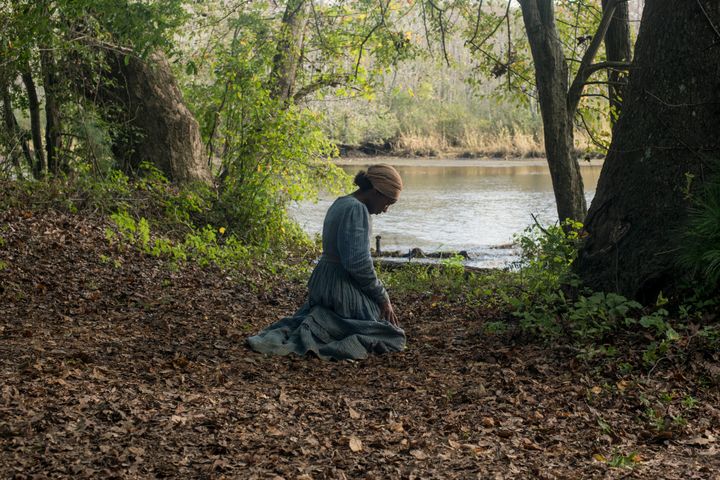[ad_1]
Kasi Lemmons “expected every kind of criticism” about her film “Harriet.” The filmmaker told me as much in September during the Toronto International Film Festival, where “Harriet” held its world premiere and where Lemmons laid out her feelings about the numerous reactions to her latest feature.
Her general feelings? “It is what it is.”
Perhaps best known for making the 1997 cult classic “Eve’s Bayou,” Lemmons is considered one of the patron saints of Black female directors, up there with trailblazers including Julie Dash and Cheryl Dunye. “Eve’s Bayou” is largely regarded as one of the most important Black films ever made, a Southern Gothic drama steeped in magic and the dark cloud of family secrets. But while Lemmons has made several movies since the release of “Eve’s Bayou” (the most recent being “Black Nativity” in 2013), “Harriet” has probably been one of her most-talked about films since, being the first feature film on the big screen about the life of Harriet Tubman.
The movie, in theaters Friday, has been haunted by controversy since it was announced in 2017 that actress Cynthia Erivo was poised to star as Tubman. For one thing, there has been criticism that a Black British actress of Nigerian descent shouldn’t be playing such an iconic African-American role. There has been even stronger criticism of Erivo’s involvement in the movie given tweets she made prior to her casting that mocked Black Americans. A hashtag, #HarrietDeservesBetter, was even created this past summer in protest.
Lemmons is aware of these concerns. When I asked her about the critiques of the movie and its casting, she acknowledged that they are important. But she also believes deeply that the film, once seen, can change minds.
“We do need to talk about it, but the point of this movie is we did it for Harriet,” Lemmons said.
“And so people will say and do with it what they will, but this is our offering to Harriet. That was the mission we were on,” she said. “That’s the way we looked at it. We put ourselves through all kinds of things to try and bring Harriet to the audience. And I think we did it right and I think we did it with the right person.”
Early reviews have varied. “Harriet” has been described as a “stunning achievement” by some critics, while others have criticized it for “hyperfocusing on the superhero elements of Tubman” rather than her humanity by playing up Tubman’s spirituality. This latter critique is interesting, given the fact that Lemmons (who also co-wrote the film’s script) says that the production of the film was a deeply spiritual experience. This filmmaking as near-religious experience, as a calling, a testimony, seems to permeate every facet of how Lemmons approached the movie.
On the first day of shooting, Lemmons and Erivo embraced each other in what the director describes as the “longest hug ever.” That hug was the starting point of a grueling three-month shoot during which the director says she felt deeply connected not only to Erivo, but also to the spirit of the film’s subject.
The director says she “prayed directly to Harriet” during the making of the film, saying Harriet’s name to herself early in the morning before going to set and right before she went to bed.
“I would wait to be able to see her and feel her. And then once I could see her and feel her, [I would ask,] ‘Are we on the right path? Is this OK? Is there something I should do? Something I should know?’” she said. “So it was very spiritual. And what was amazing was Cynthia from the first moment she came on set, [I could feel] she was emotionally prepared, physically prepared and spiritually prepared. We could feel it in each other.”

There’s a moment in the movie where Harriet has finally arrived to freedom in Philadelphia after a harrowing first escape from enslavement in Maryland. She is welcomed by the black abolitionist and historian William Still (Leslie Odom Jr.), who asks her to give an account of her life and escape for the detailed records he keeps of the newly free. Harriet explains to him that once, as a child, a former enslaver threw a metal weight at her head, splitting her skull open and leaving her in a coma for two months. When she awoke, she says, she began to receive visions and prophecies — directly from God.
Still smiles, nods politely. The camera cuts to a close-up of the page on which he’s recording her account. “Possible brain damage,” he scribbles.
This moment of skepticism is a set up to an underlying arc in “Harriet.” The son of her enslaver tells her that God doesn’t answer the prayers of black people. Harriet then prays for his father, the owner of the plantation she works on, to die, and the next day he does. Later, a group of runaways whom Harriet is guiding to freedom refuse to follow her across a dangerous river which she says God has told her is the way to safety. They then watch as she, miraculously, makes it to the other side without drowning.
The narrative, as well as Erivo’s highly principled, dutiful, and no-nonsense portrayal of Tubman, work to enforce this idea that people who wrongly question or doubt her spiritual connection to God are always proven wrong in the end. It must be said that Tubman did believe she saw visions and prophecies. The incident with her enslaver dying after she prayed for God to smite him is one recounted by Tubman herself. So the criticism about the spiritual elements in the film are interesting, given how Tubman’s spirituality was inextricably linked to her humanity.
But what is perhaps more interesting is the connection between the spirituality within the context of the film and the spirituality on Lemmons’ set. It seems the spiritual experience Lemmons and Erivo had in the making of the movie has served, in a sense, as a kind of inoculation for them against some of the criticisms of the film, particularly regarding Erivo’s past tweets. Lemmons seems to have chosen to treat it magnanimously, ultimately believing the criticism will all be irrelevant.
In the past, there’s been a natural resistance to depictions of slavery on-screen. Movies like “12 Years A Slave” and the ill-fated “Birth of a Nation” have kicked up similar debates about casting, about the Hollywood establishment’s apparent delight in so-called “trauma porn,” and about the right way to tell the story of slavery on-screen, or whether there should even be any more.
For Lemmons, there was a deep desire to provide a cinematic record of Tubman’s life, despite the idea some have that there are too many Black prestige films about slavery. To that, Lemmons challenged, “Name me five movies about slavery.”
“I can name you five about the Holocaust. I can name you 15 about Vietnam,” she said. “Extremely traumatic history needs to be examined, which is why there have been so many films about the Holocaust. Because it’s so difficult to process it. So slavery is one of those very complicated things that we’re obviously still needing to unpack.”
With “Harriet,” it’s intriguing to consider what the conversation would be if Erivo’s presence in it was not the main story. What is this movie without the apparent controversy and backlash swirling around its periphery? In other words, is it good? Is it worth it?
There are two ways to look at “Harriet.” There’s the movie that exists in the hearts and minds of its director and star, a spiritually charged labor of love literally guided by the hand and spirit of Harriet Tubman herself. This version of the film is, in Lemmons words, “entertaining” and “very, very watchable,” a movie made to uplift, provide a record, and do cinematic justice to a subject whose life story has never been told on the big screen before.
And then there is the film that exists in the hearts and minds of many Black people across social media as an artistic slap in the face to those descended from enslaved Africans. This version, to them, is perfectly competent at best, rotten at worst. It is an unwieldy creation which not only disrespects Harriet’s memory but flattens her human complexity in the process.
REAL LIFE. REAL NEWS. REAL VOICES.
Help us tell more of the stories that matter from voices that too often remain unheard.
[ad_2]
Source link

